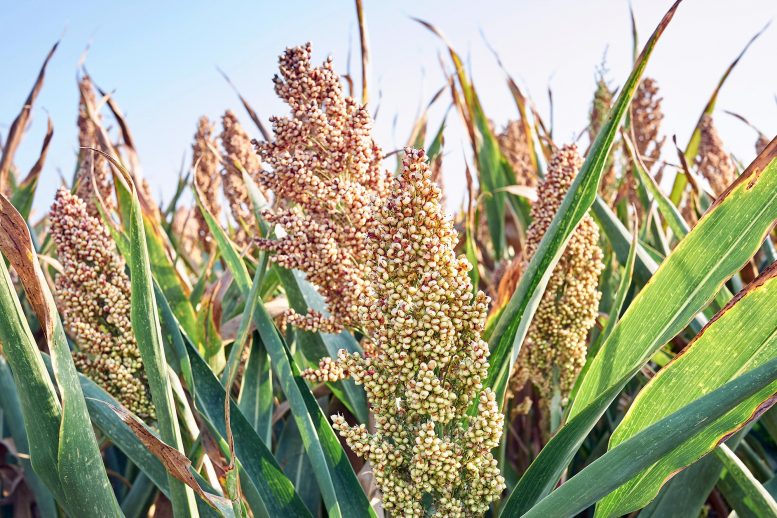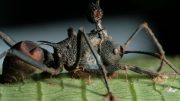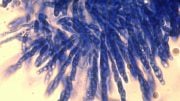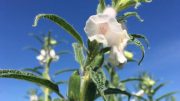
Researchers figured out how bacteria protect an important crop of grains around the world from harmful fungi. The low-cost method can also be used to protect economically important food crops from other pathogens.
Anthracnose Alert: How Bacteria Prime Fifth-Biggest Global Grain Crop Against Deadly Fungus
Anthracnose of Sorghum bicolor devastates crops of the drought- and heat-resistant cereal worldwide. Priming with rhizobacteria can boost the plants’ resistance and tolerance against a wide range of adverse conditions such as microbial attacks.
University of Johannesburg researchers decoded how priming enhances the ‘security system’ of plants for a much stronger, faster defense.
Using metabolomics and machine learning algorithms, they identified changes in the sorghum plant’s chemical response to fungal attack.
The low-cost approach can be used to counter other pathogens in economically important food crops.
Fungus modus operandi
The fungus Colletotrichum sublineolum sneaks up to its host in many ways. It may have been hanging around for years in the soil, on decaying plant matter or on equipment. It likes to pounce at the first rains in humid and warm conditions.
It enters the stomata, or “air vents” of the plant, and doesn’t wreck things at first. Rather, it multiplies inside the plant as a first priority. At this stage, it feeds on the plant without causing damage visible to the farmer.
But once the fungus has truly invaded its host, it switches from an unwanted parasite to a wholesale destroyer. As if a switch has been flicked, it starts demolishing the structural supports and cells of the plant. This way the fungus feeds its ravenous appetite and gets ready to procreate.
At this stage, the devastating disease becomes visible on the outside of the plant. Sorghum anthracnose, or wilting disease, causes spots on the leaves and stems. The spots expand into lesions that can cover leaves completely.
The invaded plant doesn’t stand a chance.
Unless friendly bacteria have teamed up with the plant beforehand. A mutual plant-bacteria interaction can switch on a plant’s “security system,” which can fend off the fungus, if it is sensitive, fast, and strong enough.
Sorghum anthracnose is caused by the fungus Colletotrichum sublineolum, or CS fungus for short. The fungus is a picky predator, as most fungi are. It specializes in attacking sorghum plants of any age. Sometimes it favors plants closer to harvest. When it does attack, it can destroy entire fields of the grain, with crop yield losses up to 70% or more.
Coping with climate
“In the era of climate change, we are expecting longer periods of drought and excessive heat. Crop plants will also have to produce during intermittent and more severe flooding. It is time to adapt our existing crop plants for the conditions approaching us,” says Prof Ian Dubery. He is the Director of the Research Center for Plant Metabolomics at the University of Johannesburg in South Africa.
Fifth biggest grain globally
The species of sorghum mostly planted for commercial or subsistence production is Sorghum bicolor. It is indigenous to Africa, and used for food, fodder, and biofuel in many countries.
By annual volume, it is the fifth-biggest grain crop in the world. Sorghum is key to food security for subsistence farmers producing the grain.
The crop is known as great millet and guinea corn in West Africa, dura in Sudan, mtama in eastern Africa, jowar in India and gaoliang in China; while it is usually referred to as milo or milo-maize in the United States, according to the FAO. Other names include feterita, jwari, shallu, cholam, jola, dari, and solam.
Certain varieties are highly drought and heat resistant.
Costly defenses
Some varieties of Sorghum bicolor are more resistant to the CS fungus than others. However, the most productive varieties tend to have less resistance to the CS fungus. In addition, activating and exercising that resistance comes at a price — to the plant and the farmer.
The harder the sorghum plant has to work at mustering its defenses, the fewer seeds it will produce. It may be able to defend itself so it has healthy leaves and stems, but it can end up producing a crop yield that is much less. It may even die in the process.
Also, spraying fungicides is expensive and can affect the environment. So a more sustainable way of protecting sorghum would be preferable.
Priming for defense
Priming sorghum plants with friendly bacteria around their roots, can make their leaves more resistant to attacks from the CS fungus. Biofertilizers which contain these rhizobacteria are used commercially for sorghum and other crops.
In industry, these are called “plant-growth promoting rhizobacteria” or PGPR. Seeds can be coated with biofertilizers, and soil or plants can be sprayed with it.
But how and why priming works to defeat pathogens such as the CS fungus on cereal crops was unknown.
Plant metabolomics decodes a tougher security system
Prof Ian Dubery and Dr. Fidele Tugizimana decoded how and why priming with rhizobacteria works on Sorghum bicolor. Tugizimana is a research associate at the Research Center.
“Sorghum plants and the rhizobacteria they are primed with, team up to get the plant ‘security system’ on higher alert. It also acts faster and with a stronger response against the attacking fungus,” says Dubery.
Without fungal attacks, the bacteria living in the rhizosphere (the area around the roots of the plant), help the plant in many ways. As an example, they make it easier for the plant to digest nutrients like phosphates; and to fix nitrogen to the soil to make it more fertile.
In its turn, the plant helps the bacteria by releasing chemicals that they need.
For peace and war
The researchers planted a sorghum variety in trays in their laboratory. After the plants reached a height of 30 cm, they applied the rhizobacteria on the roots to prime the plants. These bacteria live in the soil close to the roots of the plants, which is called the rhizosphere. The plant manufactures chemicals and sends them into the rhizosphere for the bacteria to use.
What the researchers wanted to find out, is how the “chemical communications” work in and around a healthy plant. They analyzed the chemicals synthesized by the plant in its leaves, stems, and roots, as well as bacteria-inoculated soil in the rhizosphere.
From this, they could build up a picture of how the plant roots and bacteria “talk” to each other. They could also unravel how the roots, stems, and leaves “talk” to each other to support the beneficial relationship with the bacteria.
This gave them the metabolomic “signature” of a healthy plant primed with rhizobacteria.
The other half of the plants they infected with the CS fungus to see how badly it would affect that sorghum variety. Again, they analyzed the metabolic “cocktails” in the leaves, stems, roots, and bacteria-inoculated soil. This gave them the metabolomic signature of a primed, infected plant.
Big data analytics
They repeated the whole process for the same variety of sorghum, with one exception. They didn’t prime the roots with bacteria. Now they could see how much weaker the ‘security response’ was without priming.
All of these biochemical analyses generated a huge amount of complex data, more than 200 gigabytes in volume. To make sense of all of this, they employed big data analytics, which is a complex process of examining and mining large and complex datasets.
Along the way, techniques such as machine learning, chemometrics, multivariate statistical analyses, and mathematical methods were used. In this way they could extract the information, so that more accurate conclusions and hypotheses could be drawn and confidently formulated.
Changes in chemical defense
Now they could see what new “cocktails” the sorghum plants manufactured to defend themselves. And how these cocktails were more diverse and concentrated, with help of the priming bacteria, than when the plants were healthy.
The researchers could also see what new “cocktail ingredients” the primed plants used when attacked by the CS fungus.
At one to three days after infection with the fungus, the primed plants produced several times higher quantities of plant hormones than non-primed plants, in particular hydroxyjasmonic acid-glucoside and zeatin.
The primed plants also synthesized significant quantities of the amino acids tyrosine and hydroxy-tryptophan, which non-primed plants made tiny quantities of. They also produced more than three times as much tryptophan than usual.
At the same time, the primed plants ramped up the production of lipids, especially phytosphingosine. The non-primed plants produced tiny fractions of the lipids in comparison.
The primed plants radically cut back on producing (iso)flavonoids, especially on apigenin and luteolin.
Decoding the security system
“We found that primed sorghum plants have more sensitive plant security systems. They switch these systems on sooner than they would without priming. The primed plants also responded better to fungal attack. They had much lower infection rates and reduced symptom development compared to non-primed plants,” says Tugizimana.
Even at nine days after infection with the CS fungus, few primed sorghum plants showed symptoms. The ones that had symptoms had few leaves affected. The lesions could be described as a localized hypersensitive response. None of the lesions spread over the entire leaf surface, he adds.
They found out how the plant was able to defend itself, using metabolomics analyses.
“We found out how the interaction of the beneficial bacteria with sorghum plant roots modifies the plant’s ability to defend itself. The primed sorghum plant changes how it apportions energy and redirects its metabolic pathways more to defense, rather than growth or seed production. In this way, it changes the composition of its protective chemicals to resist the fungus. This is how it starts making new ‘cocktails’ to enhance its chemical defenses.
“The primed sorghum plant is more sensitive to fungal attack, reacts quicker, and more intensely. So we can say that plant-beneficial bacteria supports the plant to launch a more efficient defense,” says Tugizimana.
Low-cost sustainable approach for farming
The results pave the way for similar studies on countering pathogens on other economically important crop plants, says Dubery.
“Priming with rhizobacteria can make a susceptible plant more tolerant and a tolerant plant more resistant to disease. This means that priming, or pre-conditioning, can enhance crop yields and reduce the use of pesticides. It is a promising, sustainable and low-cost option to get more effective resistance in real-world farming conditions, where many pathogens threaten food crops,” he adds.
Reference: “Unravelling the Metabolic Reconfiguration of the Post-Challenge Primed State in Sorghum bicolor Responding to Colletotrichum sublineolum Infection” by Fidele Tugizimana, Paul A. Steenkamp, Lizelle A. Piater, Nico Labuschagne and Ian A. Dubery, 20 September 2019, Metabolites.
DOI: 10.3390/metabo9100194
The Center for Plant Metabolomics Research at the University of Johannesburg focuses on fundamental and applied research on plant stress conditions, using metabolomics tools and approaches. Ongoing projects include phytochemical aspects of plant-microbe interactions, inducible defense responses, and innate immunity.
Prof Nico Labuschagne from the Department of Plant and Soil Science at the University of Pretoria provided a strain of Paenibacillus alvei rhizobacteria and provided a photo of the strain.
Agricol provided seeds of Sorghum [Sorghum bicolor (L.) Moench], of a sweet South African cultivar, NS 5655.
The South African National Research Foundation supported the research with grant number 95818 and fellowship support to Dr. Fidele Tugizimana. The University of Johannesburg provided fellowship support to Dr. Fidele Tugizimana.









nice information provided about the plant
we are conducting conference on plant science and molecular biology on may 18-19,2020
feel free to contact us